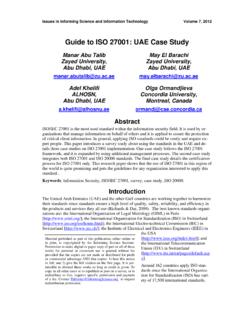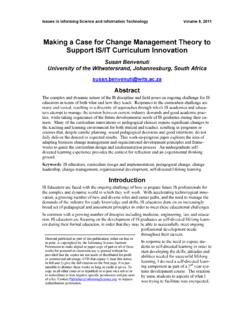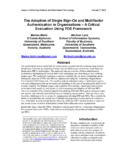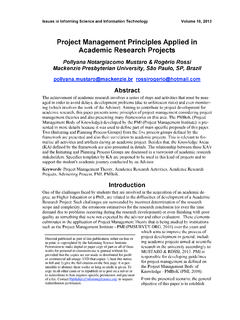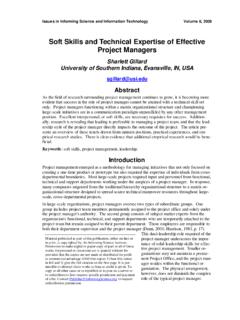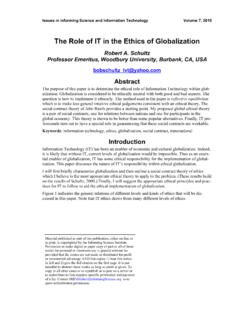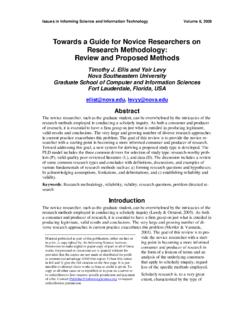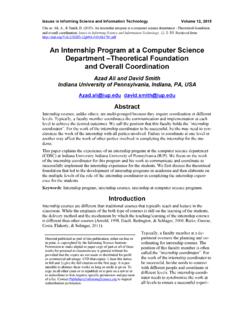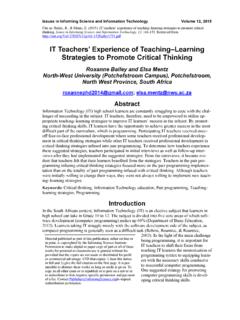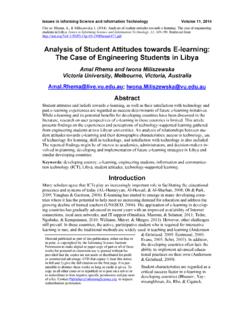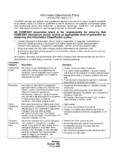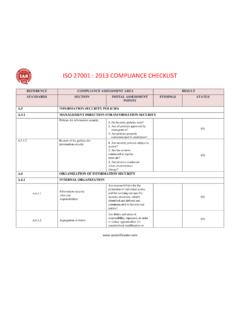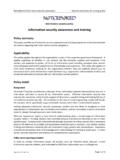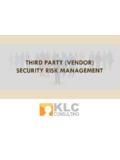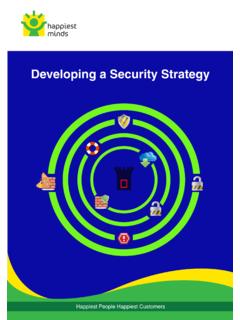Transcription of Risk Assessment of Information Technology Systems
1 Issue s in Informing Science and Information Technology Volume 6, 2009 Risk Assessment of Information Technology Systems Bo o Nikoli and Ljiljana Ru i -Dimitrijevi The Higher Education Technical School of Professional Studies, Novi Sad, Serbia Abstract Risk Assessment is a structured and systematic procedure, which is dependent upon the correct identification of hazards and an appropriate Assessment of risks arising from them, with a view to making inter-risk comparisons for purposes of their control and avoidance. There are differences in the methodology used to conduct risk assessments. This paper presents some methodologies of risk management in the IT ( Information Technology ) area.
2 In addition, a method of risk Assessment created and applied by our expert team in this area is described. As there is a similarity between these methodologies, the paper presents the use of methods from the occupational health area in the IT area. All items in the risk Assessment meth-odology for working environment and workplace are modified to IT as working environment and to an application as a workplace. In that way, the risk Assessment process in the safety analysis of an IT system is carried out by an origina l method from the occupationa l health area. Ke ywords: risk Assessment , Information Technology , risk management.
3 Introduction Information Technology , as a Technology with the fastest rate of development and application in all branches of business, requires adequate protection to provide high security. The aim of the safety analysis applied on an Information system is to identify and evaluate threats, vulnerabilities and safety characteristics. IT assets are exposed to risk of damage or losses. IT security involves protecting Information stored electronically. That protection implies data integrity, availability and confidentia lity. Nowadays, there are many types of computer crimes: money theft 44%, damage of software 16%, theft of Information 16%, alteration of data 12%, theft of services 10%, trespass 2% (Boran, 2003).
4 In order to minimize losses, it is necessary to involve risk management and risk Assessment in the areas of Information Technology and operationa l risks . Risk management and risk Assessment are the most important parts of Information Security Manage-ment (ISM). There are various defini-tions of Risk Management and Risk As-sessment [ISO 13335-2], [NIST], [ENISA Regulation], but most experts accept that Risk Management involves analys is, planning, implementation, con-M aterial p ublished as p art of this p ublication, either on-lin e or in p rint, is copy righted by the Informing Scien ce Institute. Permission to make digital or p ap er copy of p art or all of these works for p ersonal or classroom use is granted without fee p rovided that the cop ies are not made or distributed for p rofit or commer cial advantage AND that cop ies 1) bear this notice in full and 2) give the full citation on the first p age.
5 It is p er-missible to abstract these works so long as cred it is giv en. To copy in all other cases or to rep ublish or to p ost on a server or to redistribute to lists requires sp ecific p ermission and p ay ment of a fee. Contact Publisher@Informin g to request redistribution p ermission. Risk Assessment of Information Technology system 596 trol and monitoring of implemented measurements, and Risk Assessment , as part of Risk Man-agement. It consists of several processes: Risk identification, Relevant risk analys is, Risk evaluation Risk Management recognizes risk, accesses risk, and takes measures to reduce risk, as well as measures for risk maintenance on an acceptable level.
6 The main aim of Risk Assessment is to make a decision whether a system is acceptable, and which measures would provide its accept-ability. For every organization us ing IT in its business process it is significant to conduct the risk Assessment . Numerous threats and vulnerabilities are presented and their identification, analys is, and evaluation enable evaluation of risk impact, and propos ing of suitable measures and controls for its mitigation on the acceptable level. The security policy has changed in the last years. From checklists for identifying specific events, the Information security has risen onto a higher leve l, the security policy and strategy consider threats and weaknesses of the business environment, and IT infrastructure (Dhillon, 2001).
7 Risk Management In the process of risk identification, its sources are distinguis hed by a certain event or incident. In that process, the knowledge about the organization, both interna l and external, has an important role. Besides, past experiences from this or a similar organization about risk issues, are very use-ful. We can use many techniques for identifying risk: checklists, experienced judgments , flow charts, brainstorming, Hazard and Operability studies, scenario analys is, etc. In order to assess the level of risk, likelihood and the impact of incidental occurrences should be estimated. This estimation can be based on experience, standards, experiments, expert advice, etc.
8 Since every event has various and probably multiple consequences, the level of risk is calculated as a combination of like lihood and impact. Risk analysis or Assessment can be quantitative, semi-quantitative, and qua litative (Macdonald, 2004). Quantitative approach to risk Assessment assigns numerica l values to both impact and like lihood. The quantitative measure of risk calculated by statistical mode l is used to judge whether or not it is acceptable. Figure 1 represents relations between consequences, like lihood and limits of accep-tance. Event A has both low values, and ris k is acceptable as far as it is under the limits.
9 Event C is above the limits with high frequency and huge consequence. It is unacceptable, and it needs some measurements to reduce consequence and/or probability. For event B, which is in grey zone be-tween the limits, it is hard to make decision. Nikoli & Ru i -Dimitrij evi 597 Se mi-quantitative Assessment classifies threats according to the consequences and probabilities of occurrence. This approach is based on the opinion of the people making Assessment . For ex-ample , probabilities can be divided into five classes: 0 very unlikely (the probability 1 in 1000 years), 1 unlike ly (1 in 100 years), 2 rather unlikely (1 in 10 years), 3 rather like ly (once a year), 4 like ly (once a month).
10 Qualitative approach describes like lihood of consequences in detail. This approach is used in events where it is difficult to express numerical measure of risk. It is, for example , the occurrence without adequate Information and numerical data. Such analysis can be used as an initia l assess-ment to recognize risk (Harms-Ringdhai, 2001). Risk Treatment, Residual Risk, Risk Acceptance and Maintaining Evaluation of risk involves making a decision which risks require conducting measures in order to be reduced. Measurements could be technical (hardware or software), organizationa l (proce-dures), operationa l, protective, and others.
